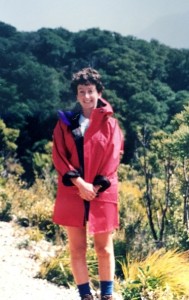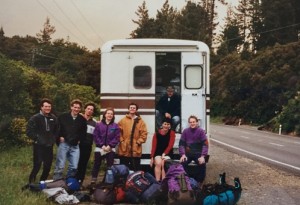This is the first in a series of interviews with some of the WTMC life members.

Sue Walsh is one of the life members that is well known to a lot of us who go to club regularly. She’s been the friendly welcoming face you saw up front on Wednesday nights for several years up until early this year. She remains a regular smiling face at club nights and you can rely on her to be helping out in all sorts of quiet ways.
Mike Gilbert spent some time chatting with her. We started with – what exactly is a WTMC Life member? It seems like something special, and the bios on the club website point to a group of accomplished individuals. But what is it all about, really?
What does an individual have to do, to become a life member?
Life membership is in recognition of sustained contribution to the club over many years. We have guidelines for this as it’s so important.
And, what would you say your contribution was?
I held a range of committee positions over many years. But life membership is more than recognising a committee contribution. In the first eight to ten years of being with the club I was out tramping a huge amount and predominantly led easy and medium trips. At one point when I looked back on that time I realised I was away virtually every second weekend. I also went to many trip planning meetings, helped other committee members, helped with bushcraft and leadership training before then going on to organise and lead these weekends for a few years. Along with Ruth Parnell we pulled together a mini bushcraft series to help with the influx of new members and then I instructed on them. I revitalised the emergency contact system, and I was also involved in helping to organise both the 50th and 60th celebrations.
Leading a trip every second week for eight years is a huge commitment! You must have got something amazing out of that, to put that much of an effort in.
It was! I met an amazing array of folk, made new friends and saw some great country. It did come at a cost at times. I remember my parents ringing me saying, “Does our daughter still exist?”
You get into a routine of gear pick up, pack, go, tramp, get home, clean wash and dry, then start over again. And of course in leading trips, there was also talking with punters, organising food and gear.
I got a real buzz introducing newcomers to the outdoors for the first time. Showing and explaining to them that no, you don’t take your boots off to cross a river for instance. It’s a really special feeling to know that your knowledge and effort has given them a new-found awareness of the outdoors and encouraged them to become members.
Why did you first join committee?
Mike Pratt asked me. “We’re looking for a secretary.” So Secretary I became. It also seemed to be a way that I could help influence things, and I had the time. I didn’t realise I would go on to be the Membership Officer, Vice President then President, let alone being the Lodge Convenor and then finally Social Convenor.
What were the issues you needed to deal with?
An example; at that time mountain biking was becoming very popular and there were discussions as to whether we, as a club, wanted to start promoting mountain bikes rides on the trip schedules. A similar issue came up with sea kayaking. There was discussion over the years about the transient nature of some of our members, recognising that Wellington drew a mixed bunch of people, some of who are here for a few years then move on. There was concern about a possible lack of understanding as to how the club works, the role of trip leader and the fact that punters can’t turn up and expect the trip leader to do everything for them. Transport was always in the background too, first regarding the demise of the Duchess, then the purchase of the bus followed by the purchase of our transit vans.
You were also the club’s first Lodge Convenor.
Yes. Previously the role was called lodge maintenance officer but my skill lay in organising and coordinating. After discussing it with the lodge subcommittee we altered the title to Convenor and divvied the work amongst the subcommittee where the skills lay. That format continues to this day, and was a wise move as the role had become very specialised.
What other ways did you help out with the Lodge?
I’d got into skiing, so I spent a lot of time at the Lodge in winter for skiing and summer for tramping too. I’ve been with the lodge subcommittee for many years as well.
There were a lot of social events there then. I was introduced to the annual winter solstice in my first year at club, then after a few years took over the organising of this for five or six years which included an excellent 50th anniversary party. We had over 40 people on the mountain. Allan MacLachlan brewed up a pretty lethal mulled wine and before we knew it the “Go Go” girls – Jo, Suzie and Janet – were dancing on the tables. It was an awesome night!

We owe a lot to the original club members for the Lodge.
Yes. Originally our Lodge was to be further up the mountain where the TTC and HVTC lodges are. Fortunately the Lift company at the time wanted that land so we were moved off. It was very fortunate that those involved chose the spot they did.
You’ve seen many changes over the years I’m sure. As Trevor Walsh’s daughter, you must have been involved from an early age.
Actually no, not really. I do have some vague early memories of being at the lodge and also staying in the hut at Walls Whare in the Waiohine Gorge.
I was always fascinated though by the outdoors and devoured many outdoor books. I was an armchair explorer and climber!
When I decided to join a tramping club I wanted to do so under my own name, not Dad’s, so, I joined another club. It didn’t go well and when one of my friends tragically died on Ruapehu I decided to call it quits.
Several years later life had moved on. I was still reading those outdoor books so decided it was time to walk the read and joined WTMC. Initially it was quite tough as I didn’t do a tramp straight away, but once I’d done my first trip I was away laughing.
How would you compare the culture of the club between then, and now?
Different! Back then you wouldn’t turn up to club in your work clothes. We stayed at road ends on the Friday night rather than backpackers or campsites. At times that could be challenging, finding a good place to put the fly up; it made a good incentive to get moving in the morning.

FE trips were still running and there was a different feel to club; technology had yet to alter life as it has now. We went through a phase of having very large groups go out on Easy trips. My largest group was 20 people – don’t know how I did all that! We sometimes had two people nominated for one committee position. We had a truck, the Duchess, for transport. Our trips left at 7pm on Fridays. We had slide presentations too.
What’s changed? Where have the FE trampers gone?
Time moves on, the club changes as membership changes. Technology has had a huge impact. When I started to lead trips I would hand write the gear and food info for my punters. Then it changed to typing it but it was still personally given to them. With the advent of email, well, that created a few ructions, particularly with concern that punters wouldn’t come to club nights and the trip leaders would meet the punters for the first time on the Friday night. Sound familiar?!
The FE tramper has changed; but we do have folk like Sharron Came, DJ, Mike Phethean and the like doing the hard trips.
The club has to evolve though and that is good as remaining static is not healthy. The challenge though is how we place ourselves moving forward without losing sight of where we came from. We have 68 years of history which I feel shouldn’t be forgotten. This is an issue committee has been looking at for a couple of years, and will probably continue to look at for a while.
After an incredibly long run, you’ve stepped down from Committee now. What are you going to do in your ‘retirement’?
It’s the club’s 70th anniversary in 2017 – a pretty significant milestone! I want to prepare a history of the club to help celebrate the 70 years . I just hope I can do justice to this project.
Can you help out with Sue’s 70th anniversary history project? Get in contact with her or leave a comment below and she’ll be in touch.
